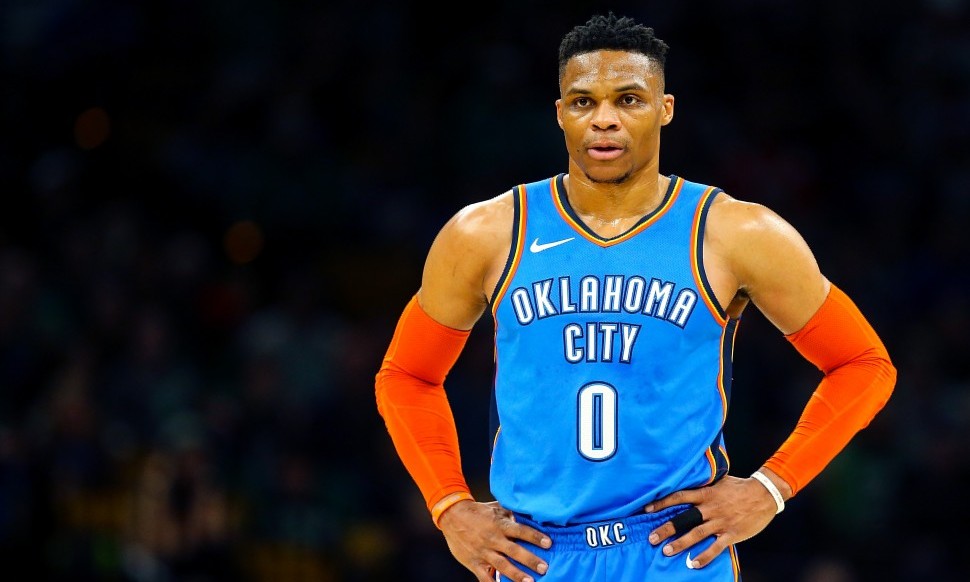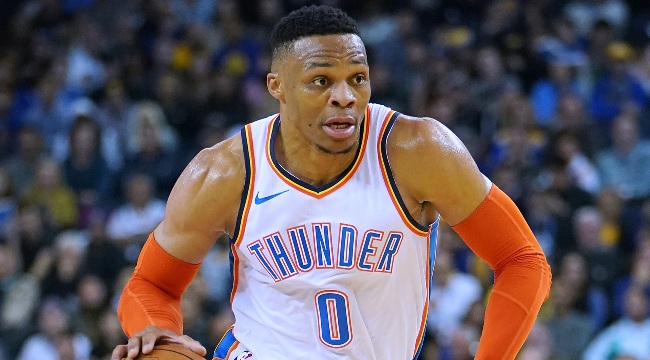
No player has been the subject of more on-court scrutiny over the past few years than Russell Westbrook. Other guys have been maligned for off-court choices (most notably his ex-teammate Kevin Durant), but Westbrook’s wildly variable style of play combined with his penchant for chasing statistical milestones has earned him quite a bit of criticism. His detractors will point to his “empty” triple doubles as proof that we’re all too focused on round numbers and that Westbrook’s third straight season doing something that had previously only been done once in NBA history is somehow a bad thing.
Perhaps the most laughed-at component of his game is how the Thunder funnel him rebounds after free throws, which has accounted for a little more than one rebound per contest over the last three seasons (since Durant left for Golden State and Oklahoma City became Westbrook-centric).
The proof is right there in his stats; there’s no arguing that the Thunder’s strategy on free throws revolves around boxing out and letting Westbrook get a free rebound. On the year, he’s grabbed 68.5 percent of available defensive rebounds after free throws, about two percentage points higher than Hassan Whiteside in Miami (the next closest player to have played at least 1,000 minutes with his current team this season).
As one would expect, the top of the list is littered with big men. The first qualifying non-big after Westbrook is James Harden at 41.8 percent and the next point guard on the list is Rajon Rondo, who “only” picks up 23.1 percent of these types of rebounds. What Westbrook is doing breaks every norm and convention surrounding point guards and rebounding, just to rack up as many triple doubles as possible.
Or, perhaps, there’s more to it than meets the eye. Perhaps funneling extra rebounds toward Westbrook does more than stroke his ego. In fact, that’s precisely the case. Just like the stats show that Oklahoma City’s rebounding scheme is designed around getting the ball to Westbrook, they also show why it’s so powerful.

The idea of getting the ball to your best player quickly after a defensive rebound is nothing new. In his heyday with the Boston Celtics, Bill Russell would often tip balls to faster teammates, who could get running in transition. Wes Unseld understood the value of a precise outlet pass before we could have ever dreamed of the kind of in-depth statistics we have today. Coaches have long known that transition offense was better than half-court offense, they just didn’t have the statistics to back up their intuition.
In this day and age, we have a statistic for just about everything (though defense, as a whole, remains a bit of a mystery), which give us hard evidence to support what those around the game of basketball have known forever. Transition offense is somewhere in the neighborhood of 25 points per 100 possessions better than half-court offense, depending on who is doing the calculations, and the best offensive teams are running extensively in order to generate as many high-efficiency looks as they possibly can.
Circling back to Westbrook, the split-seconds Oklahoma City saves by putting the ball in his hands directly off the rim help get them moving that much faster, thus increasing their post-rebound efficiency on the next possession. The very idea that each possession is its own entity and should be treated as such has been mostly debunked by taking a look at what came just before or just after each play. The Thunder have put that principle to use in perhaps the most extreme way possible.
Oklahoma City’s offense thrives in transition – they’re ranked in the bottom half of the league in half-court efficiency, yet are able to cobble together an acceptably-strong overall offensive unit due to their volume of transition opportunities. Only the run-and-gun Sacramento Kings get out in transition more often than Oklahoma City, who get nearly one in every five offensive possessions against a scrambling defense. A lot of this has to do with Westbrook, as they run nearly 30 percent more often when he’s on the floor. He’s able to spur the Thunder’s transition attack because of his “rebound hogging” tendencies, and Oklahoma City is better off for it.
Over the past three years, opponents have missed 508 free throws that turned into live rebounds against the Thunder. In that period, Oklahoma City as a whole has scored 526 points on those possessions for an unremarkable 103.5 offensive rating, per pbpstats.com. The average team’s offense after missed free throws puts up 106.0 points per 100 possessions, for comparison.
That number skyrockets when it’s Westbrook who gets the rebound, all the way up to 113.1, which would be good for third in the league behind Denver and Toronto. We’ve all seen the highlights of Westbrook taking in a miss and going coast-to-coast, but even if he’s unable to score immediately, the pressure he puts on a defense every time he picks up a rebound is unlike almost any other player in the league. The vast difference between Westbrook’s possessions and his team’s overall mark makes it even clearer that they should get the ball to him as early and often as possible. They simply don’t have anybody else on the team who can do what Westbrook does after a rebound.
After a missed field goal attempt, the results are largely similar. When it’s Westbrook grabbing the board, Oklahoma City is nearly unstoppable, to the tune of a 115.0 offensive rating over the last three years. Curb it back to the last two years (after Paul George joined the team) and that already absurd efficiency jumps to 117.9 points per 100 possessions. The league-wide average in offensive rating in these situations hovers around 111 points per 100 possessions, while only the Houston Rockets have been better than Westbrook in offensive efficiency after an opponent’s missed field goal over the last two years.
Westbrook’s stat-hungry style draws more than its fair share of criticism, but it’s not as if Oklahoma City is hurting their chances of winning in order to get him his numbers. In fact, it’s the exact opposite – going out of their way to get Westbrook as many rebounds as possible has a positive effect on their ensuing offensive possession. With that in mind, it’s no wonder Steven Adams and the rest of the Thunder box out for Westbrook at every available opportunity.
Statistics are through games completed on February 11, 2019.






